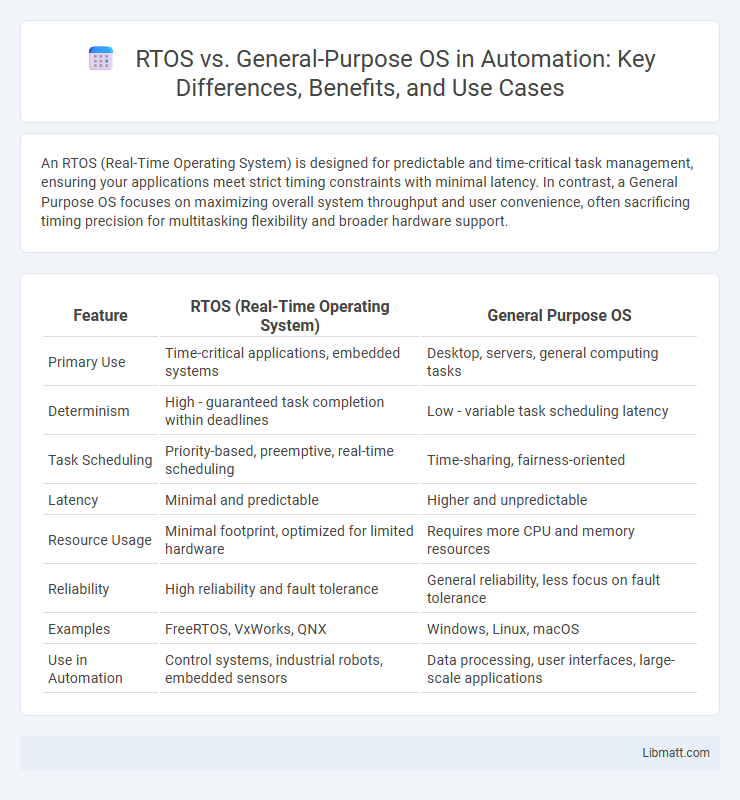An RTOS (Real-Time Operating System) is designed for predictable and time-critical task management, ensuring your applications meet strict timing constraints with minimal latency. In contrast, a General Purpose OS focuses on maximizing overall system throughput and user convenience, often sacrificing timing precision for multitasking flexibility and broader hardware support.
Table of Comparison
| Feature | RTOS (Real-Time Operating System) | General Purpose OS |
|---|---|---|
| Primary Use | Time-critical applications, embedded systems | Desktop, servers, general computing tasks |
| Determinism | High - guaranteed task completion within deadlines | Low - variable task scheduling latency |
| Task Scheduling | Priority-based, preemptive, real-time scheduling | Time-sharing, fairness-oriented |
| Latency | Minimal and predictable | Higher and unpredictable |
| Resource Usage | Minimal footprint, optimized for limited hardware | Requires more CPU and memory resources |
| Reliability | High reliability and fault tolerance | General reliability, less focus on fault tolerance |
| Examples | FreeRTOS, VxWorks, QNX | Windows, Linux, macOS |
| Use in Automation | Control systems, industrial robots, embedded sensors | Data processing, user interfaces, large-scale applications |
Introduction to RTOS and General Purpose OS
Real-Time Operating Systems (RTOS) are designed to process data and events within strict timing constraints, ensuring predictable response times crucial for embedded systems, industrial automation, and critical applications. General Purpose Operating Systems (GPOS) prioritize versatility and user experience over strict timing guarantees, supporting multitasking and broad hardware compatibility for desktops, laptops, and servers. Understanding the fundamental differences between RTOS and GPOS helps you select the appropriate OS based on the need for deterministic behavior versus general computing flexibility.
Key Differences Between RTOS and General Purpose OS
RTOS (Real-Time Operating System) is designed for deterministic, time-critical tasks, ensuring predictable response times essential for embedded systems and industrial automation, whereas General Purpose OS (GPOS) prioritizes user convenience and multitasking with variable response times. RTOS features include minimal latency, priority-based scheduling, and resource predictability, contrasting with GPOS's focus on throughput, user interfaces, and broad application support. Your choice depends on whether mission-critical timing or versatile user experience is paramount for your application.
Real-Time Requirements and Determinism
Real-Time Operating Systems (RTOS) are designed to meet strict real-time requirements by ensuring deterministic task scheduling and predictable response times, crucial for time-critical applications such as industrial automation and embedded systems. General Purpose Operating Systems (GPOS) prioritize throughput and user experience, resulting in variable latency and non-deterministic behavior unsuitable for tasks that demand precise timing guarantees. The deterministic nature of RTOS enables guaranteed deadlines, whereas GPOS often exhibit unpredictable delays due to factors like complex task management and resource contention.
Scheduling Algorithms: RTOS vs General Purpose OS
RTOS employs deterministic scheduling algorithms like Rate Monotonic Scheduling (RMS) and Earliest Deadline First (EDF) to guarantee task completion within strict deadlines, ensuring real-time responsiveness. General Purpose OS uses non-deterministic, fairness-based algorithms such as Round Robin and Multilevel Queue Scheduling, optimizing throughput and user experience rather than timing predictability. The real-time scheduling in RTOS prioritizes predictability and minimal jitter, while General Purpose OS focuses on maximizing resource utilization and interactive performance.
Resource Management and Allocation
RTOS ensures deterministic resource management by prioritizing tasks with real-time constraints, allocating CPU and memory based on strict scheduling algorithms to meet timing deadlines. General Purpose OS uses dynamic resource allocation to optimize overall system throughput and user experience, often employing complex multitasking and memory management techniques without guaranteed timing. RTOS minimizes latency and resource contention through preemptive scheduling, while General Purpose OS balances resource allocation to support diverse applications and background processes.
Latency and Response Times
Real-Time Operating Systems (RTOS) are specifically designed to provide deterministic latency and minimal response times, ensuring critical tasks execute within strict deadlines. General Purpose Operating Systems (GPOS) prioritize throughput and user convenience, often resulting in variable latency due to complex scheduling and resource management. The predictable timing behavior of RTOS makes them essential for embedded systems, industrial automation, and safety-critical applications where consistent response times are crucial.
Use Cases and Application Domains
RTOS excels in time-critical applications such as embedded systems, industrial automation, automotive control, and medical devices where predictable, low-latency response is essential. General Purpose OS like Windows or Linux supports a wide range of applications including desktop computing, web servers, and multimedia, prioritizing user convenience and multitasking over real-time performance. Industries requiring deterministic behavior and strict timing constraints predominantly rely on RTOS, while general-purpose OS serve diverse environments with less stringent timing demands.
Scalability and Flexibility
RTOS offers superior scalability by enabling precise task prioritization and deterministic response times essential for real-time applications, whereas General Purpose OS prioritizes flexibility with broad hardware compatibility and extensive software support. RTOS scalability is optimized for embedded systems requiring consistent timing, while General Purpose OS adapts more efficiently to diverse user applications and workloads. The flexible architecture of General Purpose OS supports dynamic resource management, contrasting with RTOS's fixed scheduling mechanisms designed for predictable performance.
Security and Reliability Considerations
RTOS (Real-Time Operating Systems) prioritize deterministic behavior and low-latency responses, enhancing security by minimizing unpredictability and reducing attack windows compared to General Purpose OS (GPOS). RTOS environments offer robust reliability through strict task scheduling and resource allocation, crucial for mission-critical applications like automotive safety systems and medical devices. Conversely, GPOS provide broader security features but face higher risks from complex, multitasking workloads that can introduce vulnerabilities and decrease system stability.
Choosing the Right OS for Your Application
Selecting the appropriate operating system depends on the application's real-time requirements and resource constraints. RTOS offers deterministic timing, minimal latency, and priority-based task management ideal for embedded systems, whereas General Purpose OS like Windows or Linux provide versatility and extensive support for complex applications with less stringent timing needs. Evaluating factors such as response time, system reliability, and hardware compatibility ensures the best OS choice tailored to your project's performance goals.
RTOS vs General Purpose OS Infographic

 libmatt.com
libmatt.com